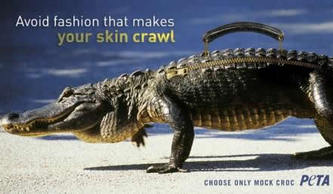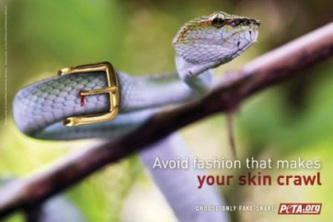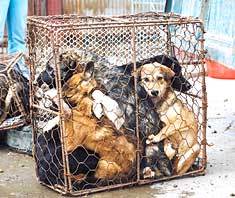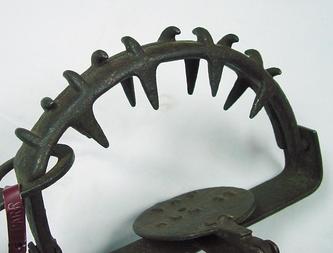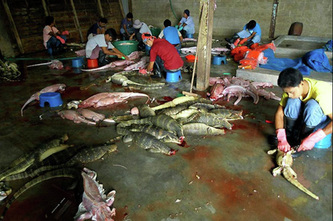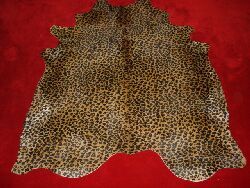Fur and skins
Although the majority of animals slaughtered for their fur come from notoriously cruel fur factory farms, trappers worldwide kill millions of raccoons, coyotes, wolves, bobcats, opossums, nutria, beavers, otters, and other fur-bearing animals every year for the clothing industry.
How a Trapped Animal Dies
There are various types of traps, including snares, underwater traps, and Conibear traps, but the steel-jaw trap is the most widely used. This simple but barbaric device has been banned or is restricted in a growing number of states across the United States, including Arizona, Colorado, California, and Washington. The European Union has banned both the use of the trap and the importation of furs from countries “that catch [wild animals] by means of leghold traps or trapping methods which do not meet international humane trapping standards."
When an animal steps on the spring of a steel-jaw trap, the trap’s jaws slam on the animal’s limb. The animal frantically struggles in excruciating pain as the trap cuts into his or her flesh, often down to the bone, mutilating the animal’s foot or leg. Some animals, especially mothers desperate to get back to their young, fight so vigorously that they attempt to chew or twist off their trapped limbs. This struggle may last for hours. Eventually, the animal succumbs to exhaustion and often exposure, frostbite, shock, and death as well.
If trapped animals do not die from blood loss, infection, or gangrene, they might be killed by predators. To prevent this, pole traps are often used. A pole trap is a form of steel-jaw trap that is set in a tree or on a pole. Animals caught in these traps are hoisted into the air and left to hang by the caught appendage until they die or the trapper arrives to kill them.
Conibear traps crush animals’ necks, applying 90 pounds of pressure per square inch. It takes animals three to eight minutes to suffocate in these traps. Victims of water-set traps, including beavers and muskrats, can take more than nine agonizing minutes to drown.
How a Trapped Animal Dies
There are various types of traps, including snares, underwater traps, and Conibear traps, but the steel-jaw trap is the most widely used. This simple but barbaric device has been banned or is restricted in a growing number of states across the United States, including Arizona, Colorado, California, and Washington. The European Union has banned both the use of the trap and the importation of furs from countries “that catch [wild animals] by means of leghold traps or trapping methods which do not meet international humane trapping standards."
When an animal steps on the spring of a steel-jaw trap, the trap’s jaws slam on the animal’s limb. The animal frantically struggles in excruciating pain as the trap cuts into his or her flesh, often down to the bone, mutilating the animal’s foot or leg. Some animals, especially mothers desperate to get back to their young, fight so vigorously that they attempt to chew or twist off their trapped limbs. This struggle may last for hours. Eventually, the animal succumbs to exhaustion and often exposure, frostbite, shock, and death as well.
If trapped animals do not die from blood loss, infection, or gangrene, they might be killed by predators. To prevent this, pole traps are often used. A pole trap is a form of steel-jaw trap that is set in a tree or on a pole. Animals caught in these traps are hoisted into the air and left to hang by the caught appendage until they die or the trapper arrives to kill them.
Conibear traps crush animals’ necks, applying 90 pounds of pressure per square inch. It takes animals three to eight minutes to suffocate in these traps. Victims of water-set traps, including beavers and muskrats, can take more than nine agonizing minutes to drown.
Exotic Animal Skins
Documentary footage shows that snakes are often skinned alive because dealers believe this practice increases the skin's suppleness. It has even been estimated that up to 90 per cent – or more – of the snakes used in fashion could be wild-caught. And according to experts, the major suspected cause of the decline in numbers of larger snake species in countries where they live is the collection of snakes for the skin trade.
Despite their dwindling populations in the wild, lizards continue to be killed in large numbers to meet the demands of the skin trade. It takes at least four lizards to make just one pair of boots, and skinning the lizards alive is preferred because of the belief that it imparts elasticity, or "give". A nail through the head holds the animals; they are then stretched out and have a knife cut into each side of their bodies so the skin can be ripped off.
Despite their dwindling populations in the wild, lizards continue to be killed in large numbers to meet the demands of the skin trade. It takes at least four lizards to make just one pair of boots, and skinning the lizards alive is preferred because of the belief that it imparts elasticity, or "give". A nail through the head holds the animals; they are then stretched out and have a knife cut into each side of their bodies so the skin can be ripped off.
Get Involved!
Visit the following websites where you can help get
involved in banishing the fur/skins industry and celebrate
cruelty free living!
http://www.furisdead.com
http://www.shedyourskin.com
http://www.bloodyburberry.com
http://www.cowsarecool.com
http://www.peta2.com/furisdead
involved in banishing the fur/skins industry and celebrate
cruelty free living!
http://www.furisdead.com
http://www.shedyourskin.com
http://www.bloodyburberry.com
http://www.cowsarecool.com
http://www.peta2.com/furisdead
